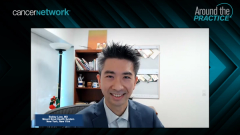
Toxicities and Drug-Drug Interactions With Frontline Therapies for mCSPC
A brief discussion on the toxicities and drug-drug interactions associated with frontline therapies in metastatic CSPC and when it would be appropriate to alter treatment to mitigate toxicity.
Episodes in this series

Transcript:
Neeraj Agarwal, MD: Simon, I’ll come back to you regarding the use of steroids; how concerning is it for patients who are going to be on this treatment for close to 3.5 to 4 years? Many patients do much longer because of the effectiveness of these therapies, that’s number 1. Number 2, how the requirement for lab testing for abiraterone may affect your patient’s decision-making. Lastly how do drug interactions make you choose abiraterone over enzalutamide and apalutamide or vice versa? I asked you 3 questions; beyond co-pay, the frequent lab checks for abiraterone, requirement for chronic steroid use even though it is a low-dose steroid and number 3 the drug interactions that we often see to be present more often with some drugs over other drugs. So how are these factors playing out in your clinic?
Simon Chowdhury, MD: All really relevant questions, and ones that we’re seeing in day-to-day practice so good to discuss them in this forum. I was fortunate enough to be involved in the STAMPEDE study, 1 of the arms of which was related to abiraterone, and we’ve seen a lot of men, just as you said, Neeraj, with patients on abiraterone, steroid, and androgen deprivation therapy for years. I have to say there are real toxicities that are there; cardiac, metabolic, bone. I think that super castration, that load of testosterone to an even lower level in our labs, beyond the level of detection for testosterone, does have an effect and I think the chronicity of the steroids does as well. We see a lot of patients who get cardiac events and I think when one looks at the relugolix data that Neil Shore presented and was in the New England Journal of Medicine, we can see that patients there with this instance of cardiac events or stroke—it’s very high. I think it’s 17% in the first year if you had a risk factor and that’s on LHRH [luteinizing hormone-releasing hormone] agonist alone; I think we have to be really aware of that. These drugs do come with a black box warning before abiraterone. I must admit the things that Bobby and Ben raised with regards to cost are absolutely important in the UK, and I think something we should all be aware of and mindful of, and really important that we spend our dollars, our pounds appropriately. Having said that, I think the toxicity issues are also important and they’re also costly so I’m moving away from abiraterone and prednisolone towards APA [apalutamide], ENZO [enzalutamide], and now perhaps DARA [daratumumab]. Drug interactions, I’ll be honest, I think less about. There are some certain drug interactions such as the newer anticoagulants that interact more with the say enzalutamide-APA and I may switch patients to ABI [abiraterone] with regards to that. I think 1 of the really important points I would say here is that these are older patients. They’re on multiple agents and I think it’s just educating them, their primary physicians, and certainly my own practice from the cardiologists. I know that you personally, because we work quite a lot together, check every single drug. Not everyone does. I think educating the patients that if they go to their primary care physician, particularly in these times of COVID-19 where we may be seeing people less regularly, every drug is important and I really think that we are missing a trick. I think some patients are progressing not because of resistance but because of drug interactions. I think in this patient population, often in the real clinic setting, they’re older with more comorbidities than we see in the more selective trial situation. Hypertension is very important as side effects from all these drugs that can be added in and as was with the patient we mentioned.
Neeraj Agarwal, MD: Thank you for sharing that with us. Coming back to Bobby for a moment, why did you choose this treatment for his patient? Bobby, how do you take into account the drug interaction part? I’m coming back to drug interaction because I’ve had some patients, as Simon said, who are on newer anticoagulants, and they do have interaction sometimes with enzalutamide and apalutamide. Do you see that as a big problem in your clinic or this is something where you would rather switch the anticoagulant instead of switching the prostate cancer treatment?
Bobby Liaw, MD: It’s a good question. I can tell you that in my own personal practice, we also, just like all of you, run into these drug interactions here and there. I think it usually boils down to what are our options for anticoagulants and what are our options for treatment of the prostate cancer? Certainly, there are much more urgent issues for anticoagulation—if someone has a saddle embolism or something, I’m not touching their anticoagulant. It’s more of an issue of which 1 is my bigger priority? Certainly, for prostate cancer, if there are other equally suitable options and I can easily make a substitution, I’m willing to do so if it’s a drug interaction issue. I have a patient who was on methadone maintenance for a very long time with very well-controlled symptoms and we tried him on apalutamide and all of a sudden his pain control went haywire. Only looking through some of the pharmacokinetics, we found that maybe there was an interaction there. These are not common. I really don’t come up against 1 of these tough decisions on a daily basis, but here and there, we do have to make a decision to switch away from 1 drug to another.
Neeraj Agarwal, MD: I’m glad you brought that up regarding the interaction of pain medicine with the novel AR [androgen receptor] inhibitors. I had a patient on fentanyl also on enzalutamide. As we know, enzalutamide decreases the level of fentanyl and we had to take a break from enzalutamide. In this circumstance, taking the break from enzalutamide can lead to increasing the level of fentanyl which can cause sedation and drowsiness and even worse complications potentially. I think it’s very important to make sure when we take a break from these novel AR inhibitors, during the clinic, we also make sure that pain medicines are adjusted accordingly. I’m so glad you brought that up. Overall, I don’t think I agree with you. I don’t think this drug interaction is really a big deal with the AR inhibitor as long as we are just being cautious and we have our pharmacy support, which is looking at the drug interactions. Again, thank you for sharing that perspective.
Transcript edited for clarity.
Newsletter
Stay up to date on recent advances in the multidisciplinary approach to cancer.





































































































